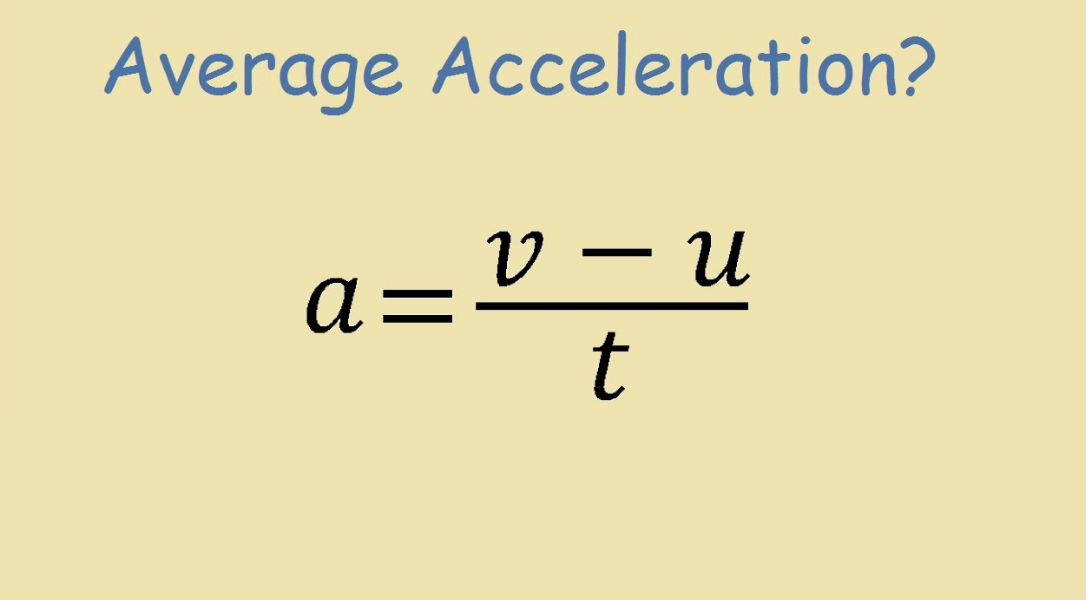There is no doubt that you are very familiar with the term average acceleration, especially in relation to cars. We say something is accelerating when it changes velocity. Acceleration is the rate at which velocity changes over time. In layman’s terms, we use acceleration to describe a state of increasing speed.
As with velocity, there are two types of acceleration: average and instantaneous. An average acceleration occurs over a long period of time. Over here, we use the word long to refer to something finite, that is, anything that has a beginning and an end. Thus, this article will focus on the average acceleration formula.

Table of Contents
Average Acceleration – Definition
The average acceleration is the rate at which the velocity changes. Calculating the average acceleration of anything involves dividing the change in velocity by the elapsed time.
For instance, if the velocity of a crazy ball increases from 0 to 60 cm/s in 3 seconds, the average acceleration of the ball would be 20 cm/s/s. This means that the marble’s velocity will increase by 20 cm/s every second.
Therefore, the average acceleration is the ratio of change in velocity to change in time for a specified interval. In contrast to instantaneous acceleration, the average acceleration is calculated for a specified interval.
Average Acceleration Formula
We know that acceleration refers to the rate of change in velocity. In other words, it is the change in velocity over a certain period of time. The average acceleration is calculated by subtracting the final velocity from the initial velocity per time. Therefore, the formula for the average acceleration formula is:
Aavg = Δv / Δt
Over here:
Aavg refers to the average acceleration, m/s2
Δv is vf – vi, m/s
Δt refers to tf – ti, s
Example
Question- Your sister just bought a new car which goes from 0 to 60 m/s in just 7 seconds. Calculate the acceleration of the car.
Answer- First, we will work with what we have. Thus, we have been given the final velocity which is vf = 60 m/s along with the initial velocity which is vi = 0. Further, our final time is tf = 7 sec in addition to the initial time which is ti = 0. Therefore, when we apply the average acceleration formula, we get:
Aavg = Δv / Δt
Aavg = (60 m/s) / 7 s
Aavg = 12.86 m/s2
Therefore, the acceleration of the car is 12.86 m/s2.
Question- A bus driver is driving along a side road at 45 m/s when suddenly he encounters a puppy running across the street. Thus, he rapidly slows down to 3 m/s within a time span of 1.5 sec. Calculate the acceleration of the bus.
Answer- Placing the figures in the equations, we will see that we have our final velocity as vf = 3 m/s and our initial velocity, vi = 45 m/s. In addition to the time we have, t = 1.5 sec. Therefore, by applying the average acceleration formula, we will get:
Aavg = Δv / Δt
Aavg = (3 m/s – 45 m/s) / 1.5 sec
Aavg = (- 42 m/s) / 1.5 sec
Aavg = – 28 m/s2
Therefore, the acceleration of the bus is -28 m/s2. It is important to note over here that the negative sign indicates the slowing down of the object.
FAQs
Because acceleration is the velocity in m/s divided by time in s, the SI units for acceleration are m/s2, meters per second squared, or meters per second per second, which literally means by how many meters per second the velocity changes every second.
The average acceleration is the change in velocity divided by the elapsed time. For instance, if the velocity of a marble increases from 0 to 60 cm/s in 3 seconds, its average acceleration would be 20 cm/s2. In other words, the marble’s velocity will increase by 20 cm/s every second.
To calculate the average acceleration, draw a straight line (shown in green) and find the gradient. Remember, gradient = acceleration. Acceleration = (15 – 0) ÷ (120 – 60) = 0.25 m/s 2.

